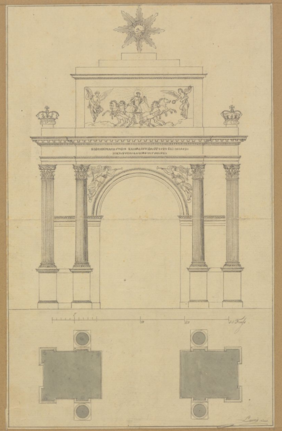In the collection of Albrecht Haupt there are only very few drawings with local reference to Hanover. Among them, a drawing by the Hanoverian court architect Georg Ludwig Friedrich Laves (1788-1864) stands out in particular. This is a design for a gate of honor, which Laves made on the occasion of the entry of King George IV into Hanover in October 1821. From the "Description of all festivities, which were organized in the Hanoverian country with the presence of His Royal Majesty George the Fourth [...]", published in 1822 by Heinrich Dittmer, it is clear that Laves provided the designs for a multiplicity of further arches of honor and small architectures, among them gates of honor for the "garden communities" of the Hanoverian suburb Herrenhausen, the villages Linden and Blumenau as well as for private clients. All in all, more than 40 such gates of honor as well as numerous smaller festive architectures lined the path that George IV traveled on his visit to his kingdom via Osnabrück, Hannover, Göttingen and Hannoversch Münden through numerous towns and villages.
The depicted Gate of Honor, donated by the citizens of the Altstadt and the Calenberger Neustadt, was the most elaborate of its kind along the route. It stood at the Steintor and was "formed in the noble classical style", which distinguishes Laves' architecture in its fine formation and proportions. The building shown here from the eastern side (in elevation) consisted of a wooden construction with Corinthian style columns, beams and cornices. The ornamental decoration with coats of arms and emblems, inscriptions, picture and relief fields with allegorical figures was provided by the court painter Johann Heinrich Ramberg (1763-1840), the theater painter Friedrich August Günther and the sculptor Heinrich Ludwig August Hengst (1796-1868).
To the regret of the contemporaries, the "colossal art object" ("colossale Kunstgebilde") was torn down again on March 18, 1822. The plan signed by Laves himself might have been used as a model for the engraving illustrated by Dittmer, from which she deviated slightly in some details. The design of ephemeral architectures such as gates of honor or catafalques belonged to the common field of work of the architects of the time. The architects often regarded the carefully executed designs as reference designs and were therefore happy to publish them or circulate them in copies.
sp

